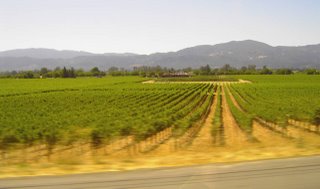 Napa Valley Tour
Napa Valley TourLeft: A pleasant Saturday afternoon, looking across the Napa Valley from the tour bus. They place lots of shiny mylar strips throughout the vineyards to ward off birds. It seems to work: at the Laird Winery, I watched a flock of birds circle around the vineyard, but after a while settle for a grove of palm trees instead.
Given the heft of the wine industry in California, the agricultural land in the Napa Valley is probably some of the most valuable agricultural land in the world. Beauty aside, land use looked tightly-controlled, but I wonder who does the controlling? Passing by the various wineries, there were indications that eccentric Iranian and Canadian wine moguls, among others, were at work in the valley, but surely they can't control everything. I wonder what would happen if you tried to open up a Wal-Mart Super Center in these fields? How long could one survive the wrath of vintners unleashed? Who would lash out hardest?
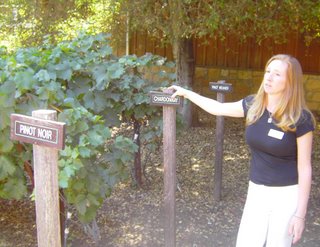 Tour guide at the Mumm Winery, illustrating the differences between grapes. The Pinot Noir grapes are purple, and small: the green Chardonnay grapes are larger. All the ripe grapes taste great, of course.
Tour guide at the Mumm Winery, illustrating the differences between grapes. The Pinot Noir grapes are purple, and small: the green Chardonnay grapes are larger. All the ripe grapes taste great, of course.Apparently the harvest started a few days ago. According to the tour guide, the winery is very, very busy of late. Nevertheless (and mysteriously), I saw no farm workers. Do they start before sunrise, so they're finished by noon when the tourists arrive? Or was Saturday A Day Without A Mexican?
 Reserve Brut, served for guests, at the Mumm Winery. The outside of this hall is very rustic, but the inside is highly-technical. No expense is spared in the Napa Valley! They take their food and wine very, very seriously here!
Reserve Brut, served for guests, at the Mumm Winery. The outside of this hall is very rustic, but the inside is highly-technical. No expense is spared in the Napa Valley! They take their food and wine very, very seriously here!On the tour, one could look through windows and see where the various highly-technical stages of bottling are carried out. The process of disgorgement was particularly interesting: freezing the used yeast in the bottle's neck and using the carbon dioxide generated from fermentation to pop the icy used-yeast cork out.
They also have a nice photo gallery here at the Mumm Winery, featuring Ansel Adams and Robert Turner, among others.
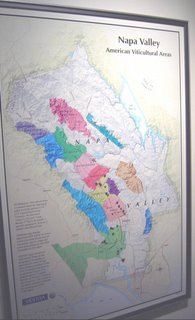 A map of the Napa Valley viticultural areas. The geography of wine is surprisingly complicated, even in such a small place like the Napa Valley. The grapes grown right at the Mumm Winery are primarily used for Cabernets and Merlots: grapes for other varieties are trucked in from elsewhere in the Valley. For examples, Chardonnays are largely grown in the Los Carneros District, where the Sonoma and Napa Valleys meet, and where the weather is more-overcast in the morning, and thus milder, than on the sunny east side of the Valley.
A map of the Napa Valley viticultural areas. The geography of wine is surprisingly complicated, even in such a small place like the Napa Valley. The grapes grown right at the Mumm Winery are primarily used for Cabernets and Merlots: grapes for other varieties are trucked in from elsewhere in the Valley. For examples, Chardonnays are largely grown in the Los Carneros District, where the Sonoma and Napa Valleys meet, and where the weather is more-overcast in the morning, and thus milder, than on the sunny east side of the Valley.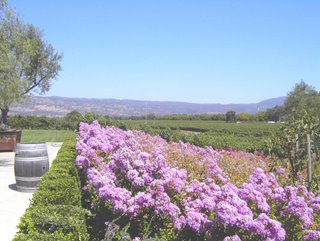 Scenic vista at the Laird Winery.
Scenic vista at the Laird Winery.At the Laird Winery, our tour guide, Linda, sat at our table. While we were drinking a Cabernet, she said "do you taste that?" We said, "do we taste what?" "That dust-like taste," she said. "That's what is called 'Rutherford Dust.' It is specific to the wines produced from grapes grown in the immediate vicinity of the town of Rutherford. Wines from Yountville, or St. Helena, or Oakville don't have this taste."
Indeed, there was a dust-like taste to the Cabernet, but I think you have to taste quite a few wines from a number of Napa Valley locations just to make sure you have 'Rutherford Dust,' and not something else, like Napa Dust, Davis Dust, or, God forbid, Sacramento Dust.
I remember a fellow, years ago when I was working at Kirtland Air Force Base, who had the ability to taste different Pepsis, and tell where in New Mexico the Pepsis were bottled, based on the taste of the water. We needed that fellow's skills on Saturday.
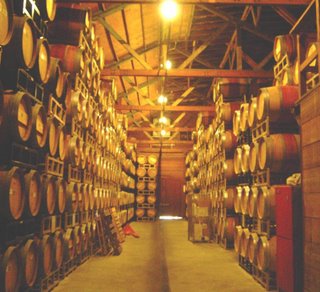 Chilled storeroom at the Merryvale Winery. Each of these barrels is made of French oak (California oak is apparently too crooked and tastes wrong to be suitable), and costs $1,000 to $1,250 each. The good thing is that the barrels can be reused (provided one doesn't try to go from red to white wine and one is willing to wait a decade, or so, for the barrel to become available).
Chilled storeroom at the Merryvale Winery. Each of these barrels is made of French oak (California oak is apparently too crooked and tastes wrong to be suitable), and costs $1,000 to $1,250 each. The good thing is that the barrels can be reused (provided one doesn't try to go from red to white wine and one is willing to wait a decade, or so, for the barrel to become available).In the Merryvale Tasting Room, we were treated to the second tasting level (Reserve). There is a description of the wines we tasted here. I really liked the Antigua Dessert Wine (but then, I've always had a sweet tooth).
 Georgette ponders giant casks (of amontillado?) in the Merryvale Winery's darkened dining hall. The sumptuous setting looked specifically designed for a Gothic novel.....
Georgette ponders giant casks (of amontillado?) in the Merryvale Winery's darkened dining hall. The sumptuous setting looked specifically designed for a Gothic novel.....
No comments:
Post a Comment